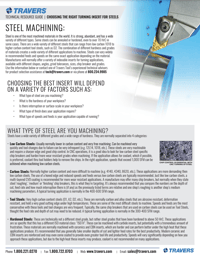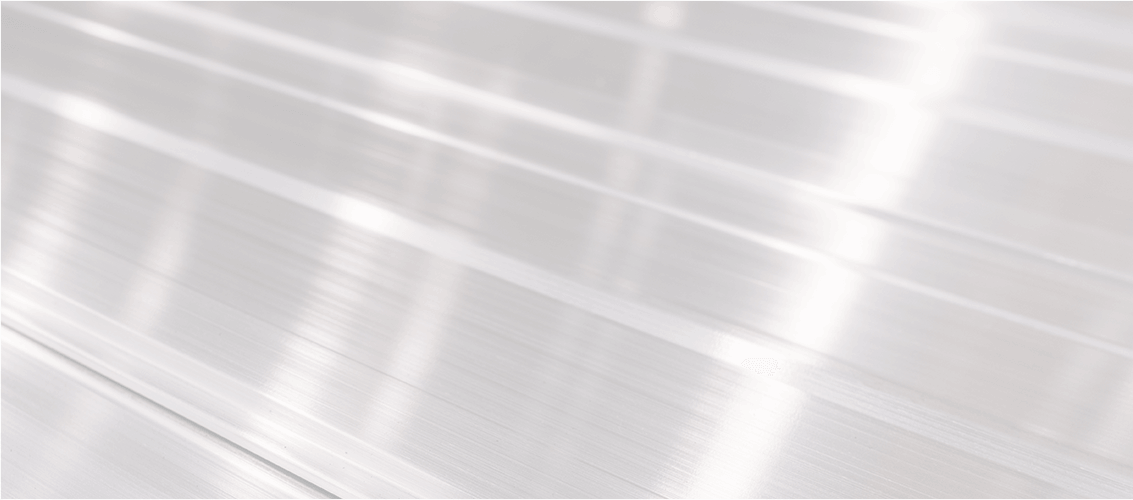Watch this video introduction to steel milling basics. Tech expert Kurt Repsher walks you through how to choose the right end mill and lubricant for your steel milling application, the pros and cons of various tool materials, helix angles, coatings, and much more! Subscribe to our YouTube Channel and be the first to see more awesome how-to videos like this one!
Steel BASICS:
Steel is machinable, and commonly found in pretty much any machine shop. The following steel milling basics will help you to hit the ground running, so you can land some good jobs and handle them like a pro.
SOME OF THE CHALLENGES:
If you’re making a part or two, it won’t really matter how hard you push the tool for maximum material removal. But if you’re making thousands of parts a week, you’ll need a more effective strategy. To effectively mill steel, you'll have to:
- Prevent tool breakage: You'll have to learn how to achieve the maximum material removal rates without breaking a tool or causing downtime.
- Keep your cool: If it gets too hot, some steels can work-harden, which will stop the tool in its tracks, potentially destroying both the tool and the workpiece. Maintaining a safe temperature is key.
- Keep friction to a minimum: The main challenge with milling steel is keeping both friction and heat to a minimum, while maintaining good chip control and evacuation.
DIFFERENT GRADES OF Steel:
To start with, all types of steel are machinable, unless it’s been surface, or through hardened. The harder you push the tool, the more you’ll notice the differences between them. As with all machining, you always need to be careful during fast, heavy cuts, especially when the tool exits the material, which is when the risk of tool chipping is at its highest.
100 Series—austenitic, general purpose
- Type 102: austenitic general purpose stainless steel.
200 Series—austenitic chromium-nickel-manganese alloys
- Type 201: austenitic that can be hardened through cold working.
- Type 202: austenitic general purpose stainless steel.
300 Series—austenitic chromium-nickel alloys
- Type 301: highly ductile, for formed products. Also hardens rapidly during mechanical working. Good weldability. Better wear resistance and fatigue strength than 304.
- Type 302: same corrosion resistance as 304, with slightly higher strength due to additional carbon.
- Type 303: free machining version of 304 via addition of sulfur and phosphorus. Also referred to as "A1" in accordance with ISO 3506.
- Type 304: the most common grade; the classic 18/8 (18% chromium, 8% nickel) stainless steel. Outside of the US it is commonly known as "A2 stainless steel", in accordance with ISO 3506 (not to be confused with A2 tool steel). The Japanese equivalent grade of this material is SUS304.
- Type 304L: same as the 304 grade but lower carbon content to increase weldability. Is slightly weaker than 304.
- Type 304LN: same as 304L, but also nitrogen is added to obtain a much higher yield and tensile strength than 304L.
- Type 305: same as 304, but with more nickel to decrease work hardening.
- Type 308: used as the filler metal when welding 304.
- Type 309: better temperature resistance than 304, also sometimes used as filler metal when welding dissimilar steels, along with inconel.
- Type 310 310S: is a highly alloyed austenitic stainless steel used for high temperature application. The high chromium and nickel content give the steel excellent oxidation resistance as well as high strength at high temperature. This grade is also very ductile, and has good weldability enabling its widespread usage in many applications.
- Type 316: the second most common grade (after 304); for food and surgical stainless steel uses; alloy addition of molybdenum prevents specific forms of corrosion. It is also known as marine grade stainless steel due to its increased resistance to chloride corrosion compared to type 304. 316 is often used for building nuclear reprocessing plants.
- Type 316L: is an extra low carbon grade of 316, generally used in stainless steel watches and marine applications, as well exclusively in the fabrication of reactor pressure vessels for boiling water reactors, due to its high resistance to corrosion. AKA "A4" in accordance with ISO 3506.
- Type 316Ti: variant of type 316 that includes titanium for heat resistance.
- Type 321: similar to 304 but lower risk of weld decay due to addition of titanium.
400 Series—ferritic and martensitic chromium alloys
- Type 405: ferritic for welding applications
- Type 408: heat-resistant; poor corrosion resistance; 11% chromium, 8% nickel.
- Type 409: least expensive type; ferritic (iron/chromium only).
- Type 410: martensitic (high-strength iron/chromium). Wear-resistant, but less corrosion-resistant.
- Type 416: easy to machine due to addition of sulfur
- Type 420: cutlery grade martensitic; excellent polish can be achieved on this steel.
- Type 430: decorative, ferritic. Good formability, but with reduced temperature and corrosion resistance.
- Type 439: ferritic grade, a higher grade version of 409. Increased chromium for improved high temperature corrosion/oxidation resistance.
- Type 440: a higher grade of cutlery steel, with more carbon, allowing for much better edge retention when properly heat-treated. It can be hardened to approximately Rockwell 58 hardness, making it one of the hardest stainless steels, available in four grades:
- Type 440A: has the least amount of carbon making this the most stain-resistant.
- Type 440B: slightly more carbon than 440A.
- Type 440C: has the greatest amount of carbon in the Type 440 variants.
- Type 440F: a free-machining variant. Contains the same high carbon content as Type 440C.
- Type 446: ferritic designed for elevated temperature service and is capable of tolerating molten copper and brass.
500 Series—heat-resisting chromium alloys
600 Series—for proprietary alloys (which are no longer given SAE grade numbers)
- 601 through 604: Martensitic low-alloy steels.
- 610 through 613: Martensitic secondary hardening steels.
- 614 through 619: Martensitic chromium steels.
- 630 through 635: Semi-austenitic and martensitic precipitation hardening stainless steels.
- Type 630: most common PH stainless, better known as 17-4; 17% chromium, 4% nickel.
- 650 through 653: Austenitic steels strengthened by hot/cold work.
- 660 through 665: Austenitic superalloys; all grades except alloy 661 are strengthened by second-phase precipitation.
900 series—austentic chromium-molybdenum alloys
- Type 904: similar to 316 but with higher chromium and molybdenum content for more corrosion resistance.
CUTTING TOOLS FOR Steel:

Try to avoid using two or three flute end mills for steel. Technically they’ll work, but steel isn’t the easiest material to cut, so those 2 or 3 cutting edges will wear pretty fast. Here are a few tips on tool selection:
Cutting Tool Material:
- High Speed Steel is the least expensive but offers the shortest life and the slowest operation.
- Cobalt is a better choice than High Speed Steel, and only slightly more expensive.
- Solid Carbide is the longest lasting end mill material, but it’s fragile, so treat it with care.
Flutes:
- More flutes result in less work per tooth, which extends tool life. Those additional flutes come at a price though.
- An end mill with 4 flutes is a good choice most of the time. It’s the ideal balance of tool strength, chip clearance and reduced chatter. Larger end mills, 1-1/2” and up, might perform better with more flutes.
- Center cutting end mills are better for ramping and plunging operations.
Helix Angle:
- A lesser helix angle will run cooler—since it’s spending less time in the steel.
- A higher helix is smoother cutting, gives a great surface finish.
- For roughing, a lower helix angle of about 30° works great. The tool stays cooler, and nobody cares about surface finish when roughing anyway.
- A higher helix angle of 45° is an excellent choice for finishing. Light finishing cuts don’t generate much heat and it leaves a beautiful and more accurate surface finish.
- For both roughing and finishing, use a 40° helix angle as a good compromise.
Tool Finish/Coating:
- In general, uncoated end mills will work, but a coated cutter will work better. The most common coatings are: TiN, TiCN, TiAlN and AlTiN.
- TiN (Titanium Nitride): an inexpensive, general-purpose coating.
- TiCN (Titanium Carbon Nitride): the addition of carbon can improve the tool’s surface hardness over TiN coating.
- TiAlN (Titanium Aluminum Nitride): bridges the gap between TiCN and AlTiN, and the use of coolant is optional.
- AlTiN (Aluminum Titanium Nitride): is for the hardest of machinable materials and withstands the highest temperatures. The use of coolant is optional.
Corner Radius:
- Solid carbide is extremely hard, which makes it brittle.
- While cutting steel, it’s easy to chip the corner of the cutting edge. If you can, use an end mill with a corner radius to reduce the risk of corner chipping.
FEEDS AND SPEEDS:
- For production, you want to push the tool as fast as you can, while keeping tool failure minimized.
- Feeds & Speeds will be all over the charts when milling steel, depending on the grade of steel, tool material, depth and width of cuts, number of flutes, etc.
- Most (if not all) charts don’t include some of the important parameters. Use a good, comprehensive F&S calculator to reduce or eliminate guesswork.
- Start conservatively and gradually push Feeds & Speeds after some success.
- As end mill dulls, reduce both the Feed, and Speed to avoid tool breakage, and damage to the workpiece.
CUTTING FLUID:
- 1st choice: Flood coolant, if it can be used in your application/operation.
- 2nd choice: Thicker, stickier cutting oil.
- 3rd choice: Almost anything. Something is better than nothing.
- May not be needed, depending on the coating on the insert or end mill.
COMMON OPERATIONS:
Facing:
- If you’re going to use an indexable face mill, try to find something that uses negative inserts, and use coated inserts. You’ll be able to use both sides of the inserts, and you’ll be able to really push the feed rate and RPM (Feed & Speed).
- If you’re using an end mill, try to find one with a corner radius. It will last many times longer, and it doesn’t add much cost.
Slotting:
- Select an end mill that has the same, or only slightly longer flute length and the slot’s depth of cut.
- A stub length tool is significantly stronger, which reduces tool deflection.
- For deep slotting, use an end mill with a short flute length and a reduced neck diameter.
Pocketing:
- Your step over can be close to the full diameter of the tool.
- As with any material, use a tool diameter that’s slightly smaller than an inside radius. This will leave a smoother surface finish in the corners and the machine is also able to run at higher speeds while rounding those corners.
- Always use a center cutting end mill while ramping or plunging.
- Follow the same flute length rule as we used for slotting.
ORDER OF PRIORITIES:
#1) Cutting Parameters:
- Width & depth of cut
- Feed rate
- RPM
#2) Cutter geometry:
- Something suitable for my budget and operation (roughing, finishing, etc.).
- Helix angle, carbide grade, number of flutes, etc.
#3) Cutter coatings/finish:
- TiN, TiCN, AlTiN or TiAlN
#4) Type of coolant or cutting oil:
- May not be needed, depending on the coating used.
- Thicker, stickier cutting fluid or tapping oil.
- Flood coolant is best, where applicable.
Ultimately, if you really want to excel with machining steel, you’ll need to do some experimenting. Contact our tech support team for process improvement advice and steel milling product recommendations.
WAnt to learn more about STEEL Machining?
We believe the right tool is everything! Download our Steel Turning & Machining Guide and ensure you have the information you need to select the right tool for your steel machining applications, every time!
By downloading the Steel Machining Guide you'll find information on:
- How to select the best turning insert for the steel you're working on
- Speed & feed recommendations for the steel you're working on
- How scale & surface interruption should impact your insert choice
- How to select the right turning insert for the finish you require
- What chip breaker to use for your application
- How to approach your steel turning applications




